Quantifying Topological Flexibility of Active Distribution Networks Based on Community Detection
Abstract
1. Introduction
- The proposed topological flexibility quantification method quantifies the capability of ADNs to provide effective structural transformations based on the switch combination where the switches are not limited to fixed locations;
- Community detection is applied to partition the distribution network and analyze aggregation characteristics of nodes;
- An improved spectral clustering algorithm is employed to achieve the significant dimensionality reduction of partition space, which avoids the curse of dimensionality.
2. Structure of Active Distribution Networks
2.1. Graph-Based Topology Model of Distribution Network
- All distribution lines are abstracted as unweighted edges in the distribution network topology model, ignoring the different electrical characteristics and voltage levels of distribution lines;
- All the power nodes, load nodes, and the root nodes connected to the upper power grid in the distribution network topology model are abstracted as undifferentiated nodes in the graph, and the ground points are not considered;
- The directivity of the distribution network graph is ignored.
2.2. Spectral Clustering
2.3. Community Detection by Using Improved Spectral Clustering
3. Topological Flexibility Quantification Framework Based on Community Structure
3.1. Topological Flexibility
3.2. Definition of Topological Flexibility Metric
3.2.1. Topological Flexibility within Community
3.2.2. Topological Flexibility of ADNs
3.3. Computing Topological Flexibility Metric
3.4. Comparisons with the State of the Art Methods
4. Case Study
4.1. Community Structure in ADNs
4.2. Efficiency of Topological Flexibility Quantification Method
4.3. Influencing Factors of the Topological Flexibility Metric
4.3.1. Diminishing Marginal Utility of the Topological Flexibility Metric
4.3.2. Influence of Switch Allocation on Topological Flexibility Metric
4.3.3. Application of Topological Flexibility Quantization to Multi-Scale ADNs
5. Conclusions
Author Contributions
Funding
Acknowledgments
Conflicts of Interest
References
- D’Adamo, C.; Jupe, S.; Abbey, C. Global survey on planning and operation of active distribution networks: Update of CIGRE C6.11 working group activities. In Proceedings of the 20th International Conference on Electricity Distribution (CIRED 2009), Prague, Czech Republic, 8–11 June 2009; pp. 1–4. [Google Scholar]
- Zhao, J.; Zheng, T.; Litvinov, E. A unified framework for defining and measuring flexibility in power system. IEEE Trans. Power Syst. 2016, 31, 339–347. [Google Scholar] [CrossRef]
- Ulbig, A.; Andersson, G. On operational flexibility in power systems. In Proceedings of the 2012 IEEE Power and Energy Society General Meeting, San Diego, CA, USA, 22–26 July 2012; pp. 1–8. [Google Scholar]
- Ulbig, A.; Andersson, G. Analyzing operational flexibility of electric power systems. In Proceedings of the 2014 Power Systems Computation Conference (PSCC), Wroclaw, Poland, 18–22 August 2014; pp. 1–8. [Google Scholar]
- Lannoye, E.; Flynn, D.; O’Malley, M. Evaluation of power system flexibility. IEEE Trans. Power Syst. 2012, 27, 922–931. [Google Scholar] [CrossRef]
- Nosair, H.; Bouffard, F. Flexibility envelopes for power system operational planning. IEEE Trans. Sustain. Energy 2015, 6, 800–809. [Google Scholar] [CrossRef]
- Capasso, A.; Falvo, M.C.; Lamedica, R.; Lauria, S.; Scalcino, S. A new methodology for power systems flexibility evaluation. In Proceedings of the 2005 IEEE Russia Power Tech, St. Petersburg, Russia, 27–30 June 2005; pp. 1–6. [Google Scholar]
- Karthikeyan, N.; Pillai, J.R.; Bak-Jensen, B.; Simpson-Porco, J.W. Predictive control of flexible resources for demand response in active distribution networks. IEEE Trans. Power Syst. 2019, 34, 2957–2969. [Google Scholar]
- Kumar, A.; Srivastava, S.C.; Singh, S.N. A zonal congestion management approach using real and reactive power rescheduling. IEEE Trans. Power Syst. 2004, 19, 554–562. [Google Scholar] [CrossRef]
- Kumar, A.; Srivastava, S.C.; Singh, S.N. Congestion management in competitive power market: A bibliographical survey. Electr. Power Syst. Res. 2005, 76, 153–164. [Google Scholar] [CrossRef]
- Das, D. A fuzzy multiobjective approach for network reconfiguration of distribution systems. IEEE Trans. Power Deliv. 2005, 21, 202–209. [Google Scholar] [CrossRef]
- Zhu, J.Z. Optimal reconfiguration of electrical distribution network using the refined genetic algorithm. Electr. Power Syst. Res. 2002, 62, 37–42. [Google Scholar] [CrossRef]
- Savier, J.S.; Das, D. Impact of network reconfiguration on loss allocation of radial distribution systems. IEEE Trans. Power Deliv. 2007, 22, 2473–2480. [Google Scholar] [CrossRef]
- Rao, R.S.; Narasimham, S.V.L.; Raju, M.R.; Rao, A.S. Optimal network reconfiguration of large-scale distribution system using harmony search algorithm. IEEE Trans. Power Syst. 2010, 26, 1080–1088. [Google Scholar]
- Zhou, Q.; Zhang, G.; Li, J.; Yang, Z. Distribution Network reconfiguration based on strategy of breaking up the whole into parts and improved binary differential evolution algorithm. Power Syst. Technol. 2012, 36, 197–203. [Google Scholar]
- De Assis, L.S.; Gonzalez, J.F.; Usberti, F.L.; Lyra, C.; Cavellucci, C.; Von Zuben, F.J. Switch allocation problems in power distribution systems. IEEE Trans. Power Syst. 2015, 30, 246–253. [Google Scholar] [CrossRef]
- Wang, C.; Sun, C.; Li, P.; Wu, J.; Xing, F.; Yu, Y. SNOP-based operation optimization and analysis of distribution network. Automat. Electr. Power Syst. 2015, 39, 82–87. [Google Scholar]
- Esfahani, P.M.; Vrakopoulou, M.; Margellos, K.; Lygeros, J.; Andersson, G. Cyber attack in a two-area power system: Impact identification using reachability. In Proceedings of the 2010 American Control Conference, Baltimore, MD, USA, 30 June–2 July 2010; pp. 962–967. [Google Scholar]
- Watts, D.J.; Strogatz, S.H. Collective dynamics of ‘small-world’ networks. Nature 1998, 393, 440–442. [Google Scholar] [CrossRef]
- Barabási, A.L.; Albert, R. Emergence of scaling in random networks. Science 1999, 286, 509–512. [Google Scholar] [CrossRef]
- Meng, Z.; Lu, Z.; Song, J. Comparison analysis of the small-world topological model of Chinese and American power grids. Automat Electr. Power Syst. 2004, 28, 21–24. [Google Scholar]
- Lancichinetti, A.; Fortunato, S.; Kertész, J. Detecting the overlapping and hierarchical community structure in complex networks. New J. Phys. 2009, 11, 033015. [Google Scholar] [CrossRef]
- Shen, H.W. Detecting the overlapping and hierarchical community structure in networks. In Community Structure of Complex Networks; Springer: Berlin/Heidelberg, Germany, 2013; pp. 19–44. [Google Scholar]
- Albert, R.; Albert, I.; Nakarado, G.L. Structural vulnerability of the North American power grid. Phys. Rev. E 2004, 69, 025103. [Google Scholar] [CrossRef]
- Ding, M.; Han, P. Vulnerability assessment to small-world power grid based on weighted topological model. Proc. Chin. Soc. Elect. Eng. 2008, 28, 20–25. [Google Scholar]
- Carreras, B.A.; Lynch, V.E.; Dobson, I.; Newman, D.E. Critical points and transitions in an electric power transmission model for cascading failure blackouts. Chaos 2002, 12, 985–994. [Google Scholar] [CrossRef]
- Liu, R.; Feng, S.; Shi, R.; Guo, W. Weighted graph clustering for community detection of large social networks. Procedia Comput. Sci. 2014, 31, 85–94. [Google Scholar] [CrossRef]
- Wei, Z.; Liu, J.; Cheng, F.; Song, Q.; Deng, J.; Cheng, X. Fast power network partitioning method in Mvar control space based on community wining. Proc. Chin. Soc. Elect. Eng. 2011, 31, 166–172. [Google Scholar]
- Kamwa, I.; Pradhan, A.K.; Joos, G.; Samantaray, S.R. Fuzzy partitioning of a real power system for dynamic vulnerability assessment. IEEE Trans. Power Syst. 2009, 24, 1356–1365. [Google Scholar] [CrossRef]
- Fortunato, S. Community detection in graphs. Phys. Rep. 2010, 486, 75–174. [Google Scholar] [CrossRef]
- Shi, J.; Malik, J. Normalized cuts and image segmentation. IEEE Trans. Pattern Anal. Mach. Intell. 2000, 22, 888–905. [Google Scholar]
- Chen, W.Y.; Song, Y.; Bai, H.; Lin, C.J.; Chang, E.Y. Parallel spectral clustering in distributed systems. IEEE Trans. Pattern Anal. Mach. Intell. 2011, 33, 568–586. [Google Scholar] [CrossRef]
- Von Luxburg, U. A tutorial on spectral clustering. Stat. Comput. 2007, 17, 395–416. [Google Scholar] [CrossRef]
- Newman, M.E.; Girvan, M. Finding and evaluating community structure in networks. Phys. Rev. E 2004, 69, 026113. [Google Scholar] [CrossRef]
- Jin, H.; Wang, S.; Li, C. Community detection in complex networks by density-based clustering. Physica A 2013, 392, 4606–4618. [Google Scholar] [CrossRef]
- Yang, C.; Bruzzone, L.; Sun, F.; Lu, L.; Guan, R.; Liang, Y. A fuzzy-statistics-based affinity propagation technique for clustering in multispectral images. IEEE Trans. Geosci. Remote Sens. 2010, 48, 2647–2659. [Google Scholar] [CrossRef]
- Zhang, H.; Liu, H.; Jiang, C.; Chu, X.; Nallanathan, A.; Wen, X. A practical semidynamic clustering scheme using affinity propagation in cooperative picocells. IEEE Trans. Veh. Technol. 2014, 64, 4372–4377. [Google Scholar] [CrossRef]
- Li, M.; Lu, Y.; Wang, J.; Wu, F.X.; Pan, Y. A topology potential-based method for identifying essential proteins from PPI networks. IEEE/ACM Trans. Comput. Biol. Bioinform. 2015, 12, 372–383. [Google Scholar] [CrossRef] [PubMed]
- Rao, R.S.; Ravindra, K.; Satish, K.; Narasimham, S.V.L. Power loss minimization in distribution system using network reconfiguration in the presence of distributed generation. IEEE Trans. Power Syst. 2012, 28, 317–325. [Google Scholar] [CrossRef]
- Jabr, R.A.; Singh, R.; Pal, B.C. Minimum loss network reconfiguration using mixed-integer convex programming. IEEE Trans. Power Syst. 2012, 27, 1106–1115. [Google Scholar] [CrossRef]
- Dan, X.; Wei, T. Reliability evaluation of complex distribution networks based on regional accessibility analysis. Trans. China Electrotech. Soc. 2011, 26, 172–178. [Google Scholar]
- Guimaraes, M.A.N.; Castro, C.A. Reconfiguration of distribution systems for loss reduction using tabu search. In Proceedings of the 15th Power System Computation Conference (PSCC), Liege, Belgium, 22–26 August 2005; pp. 1–6. [Google Scholar]
- Civanlar, S.; Grainger, J.J.; Yin, H.; Lee, S.S.H. Distribution feeder reconfiguration for loss reduction. IEEE Trans. Power Deliv. 1988, 3, 1217–1223. [Google Scholar] [CrossRef]
- Schneider, K.P.; Mather, B.A.; Pal, B.C.; Ten, C.W.; Shirek, G.J.; Zhu, H.; Fuller, J.C.; Pereira, J.L.R.; Ochoa, L.F.; de Araujo, L.R.; et al. Analytic considerations and design basis for the IEEE distribution test feeders. IEEE Trans. Power Syst. 2017, 33, 3181–3188. [Google Scholar]
- Latora, V.; Nicosia, V.; Russo, G. Complex Networks: Principles, Methods and Applications, 1st ed.; Cambridge University Press: Cambridge, UK, 2017; pp. 13–65. [Google Scholar]

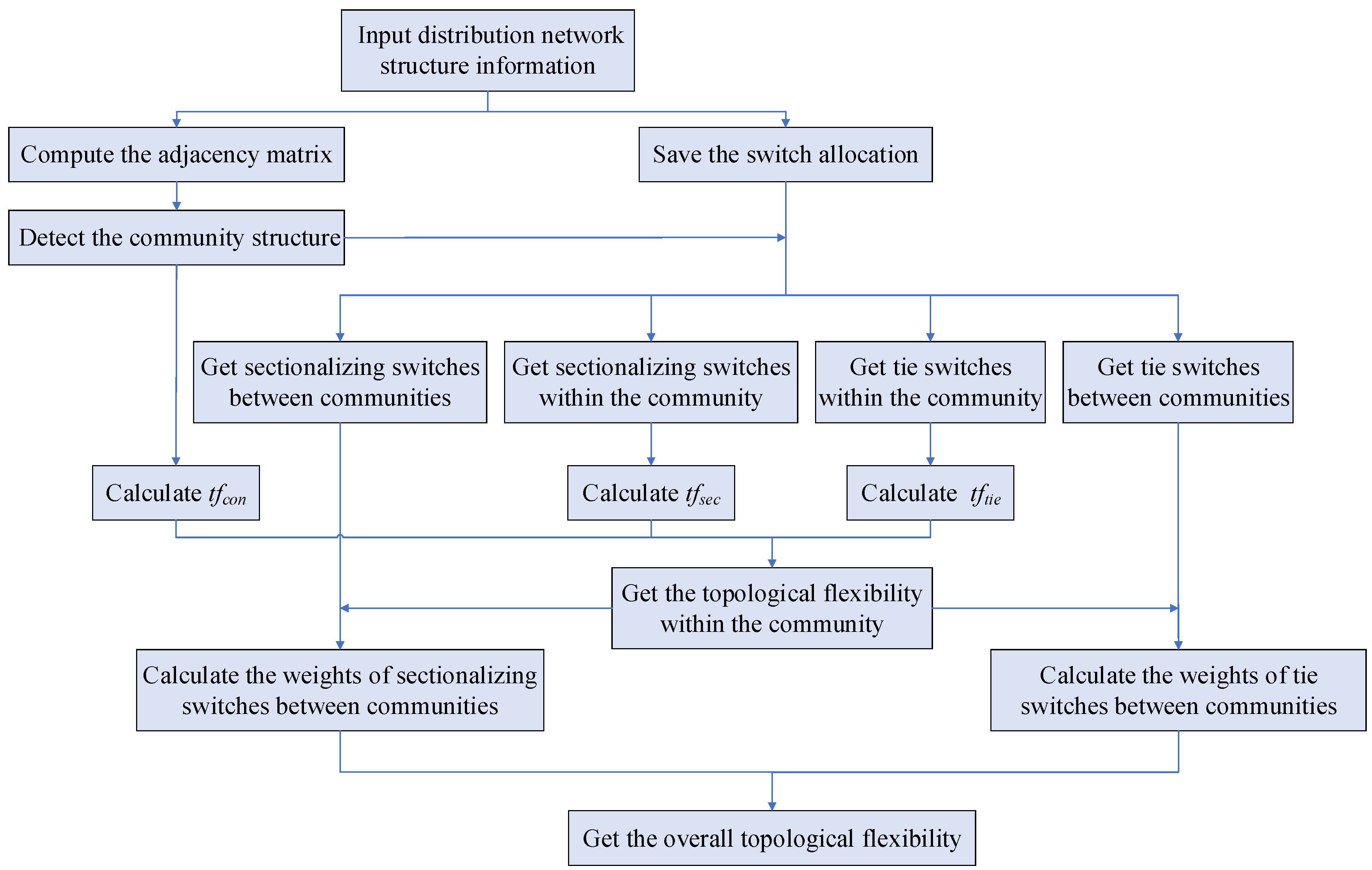
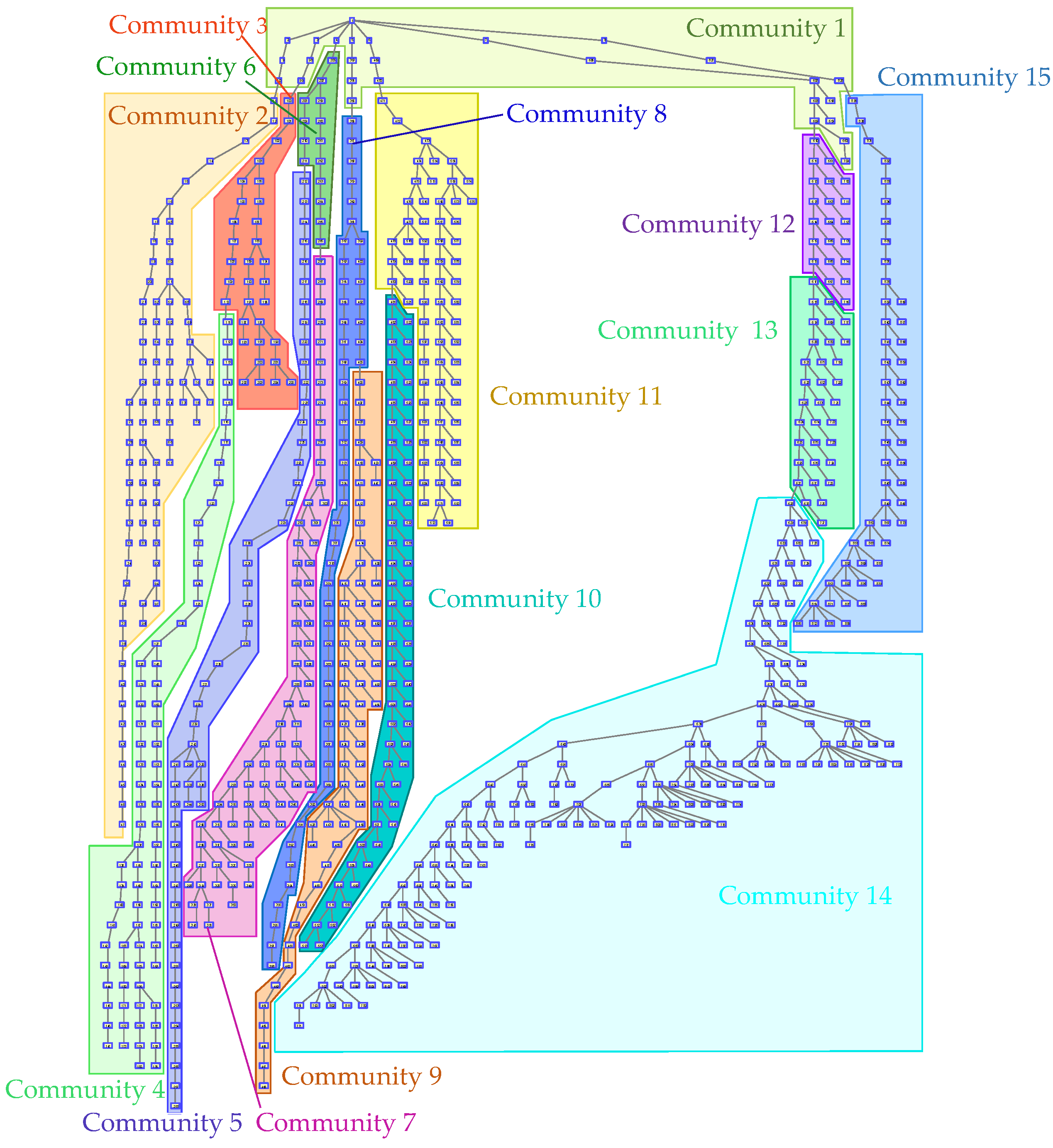

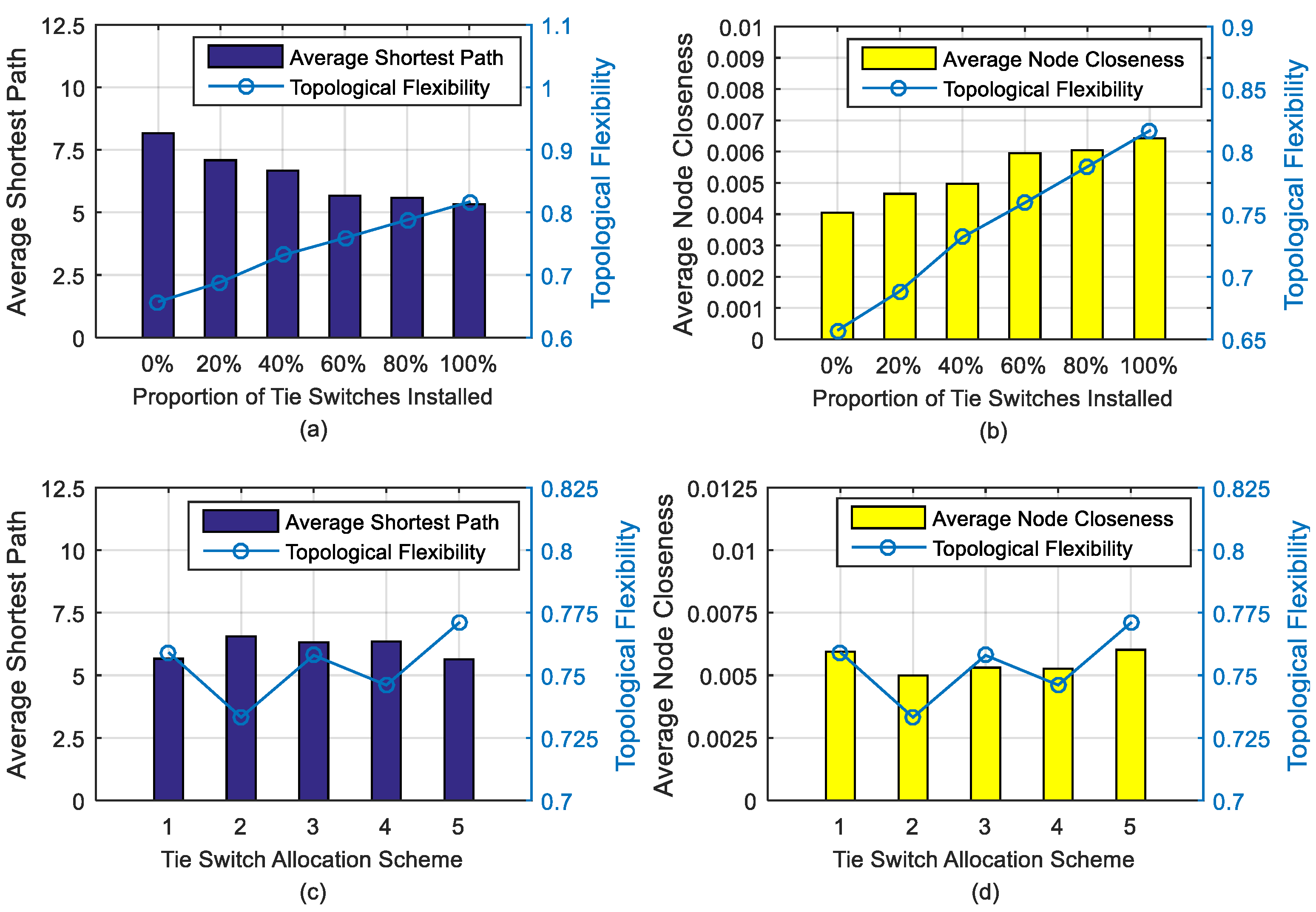
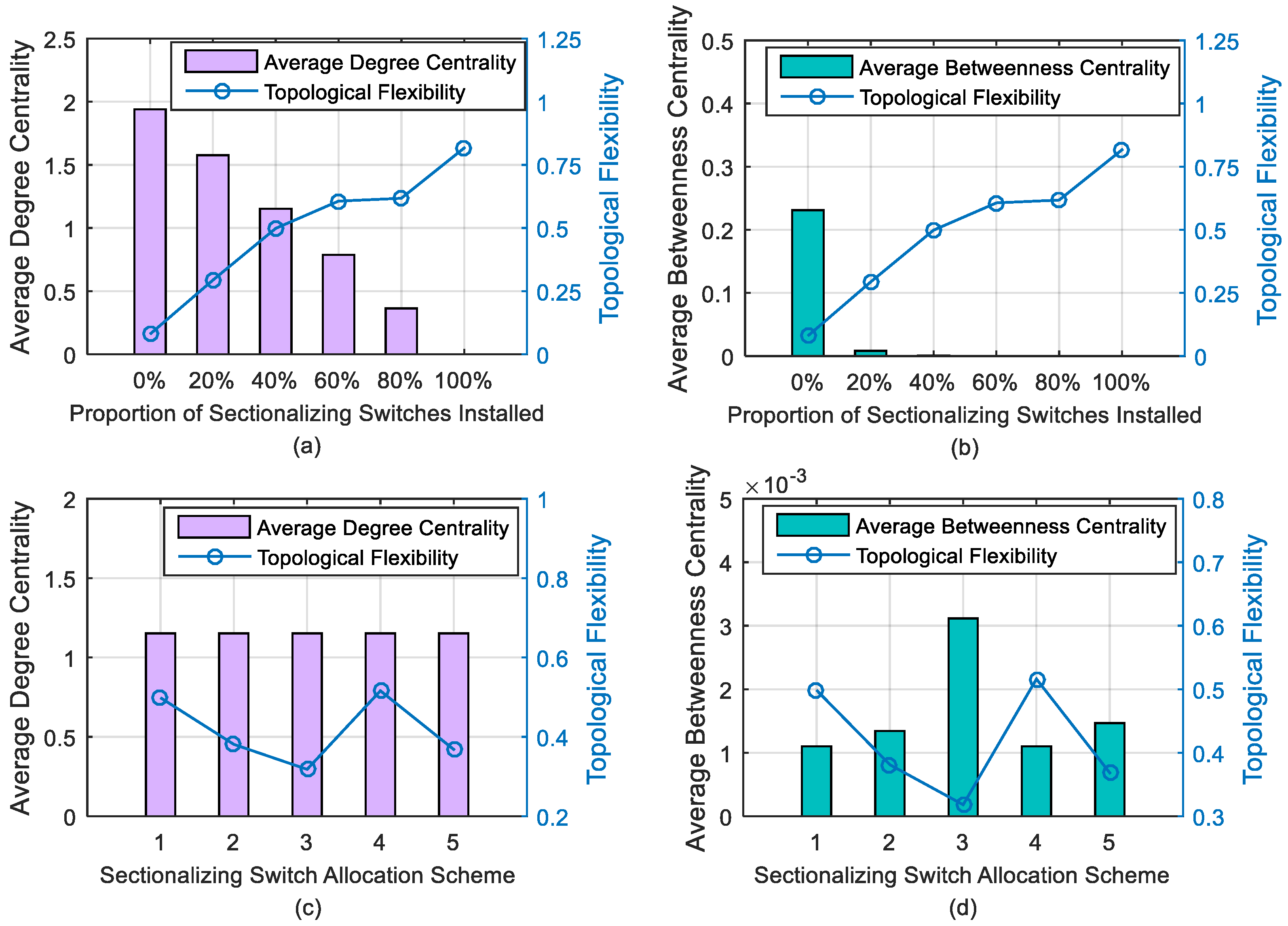

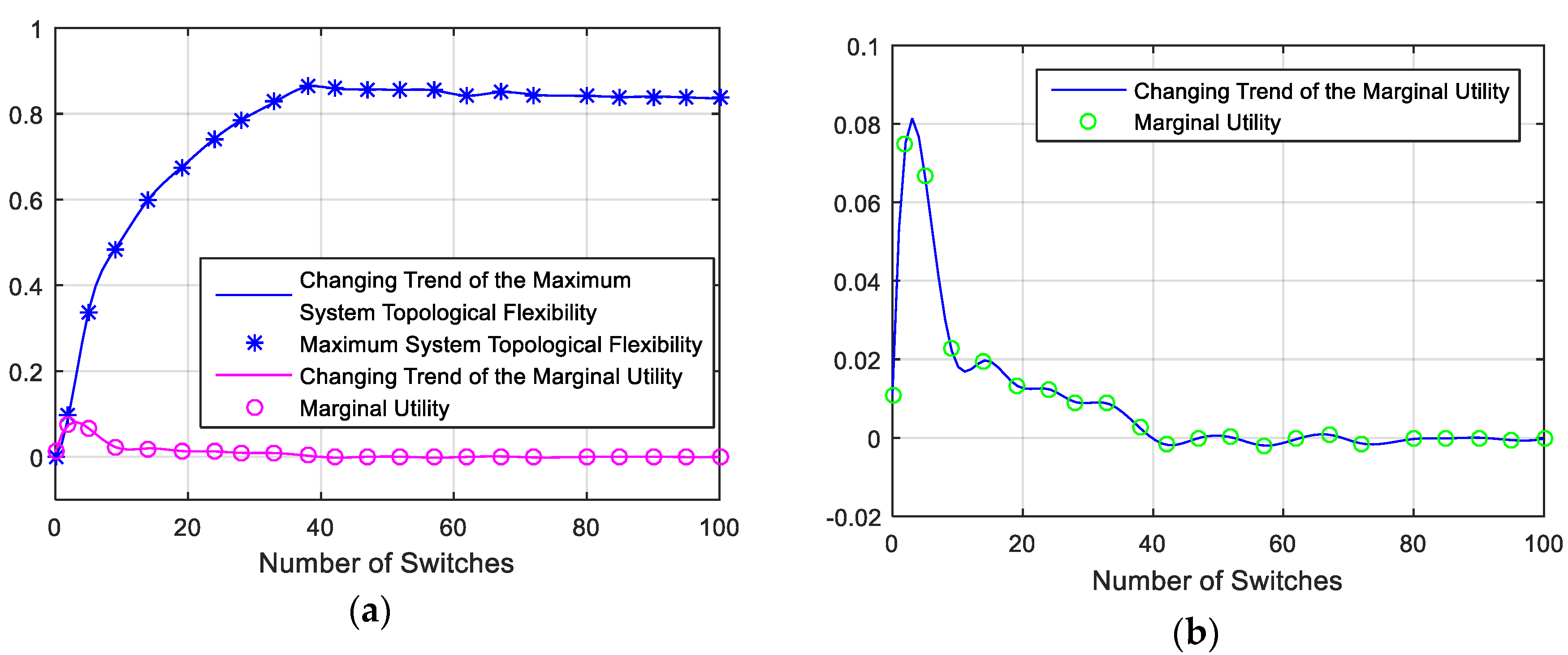
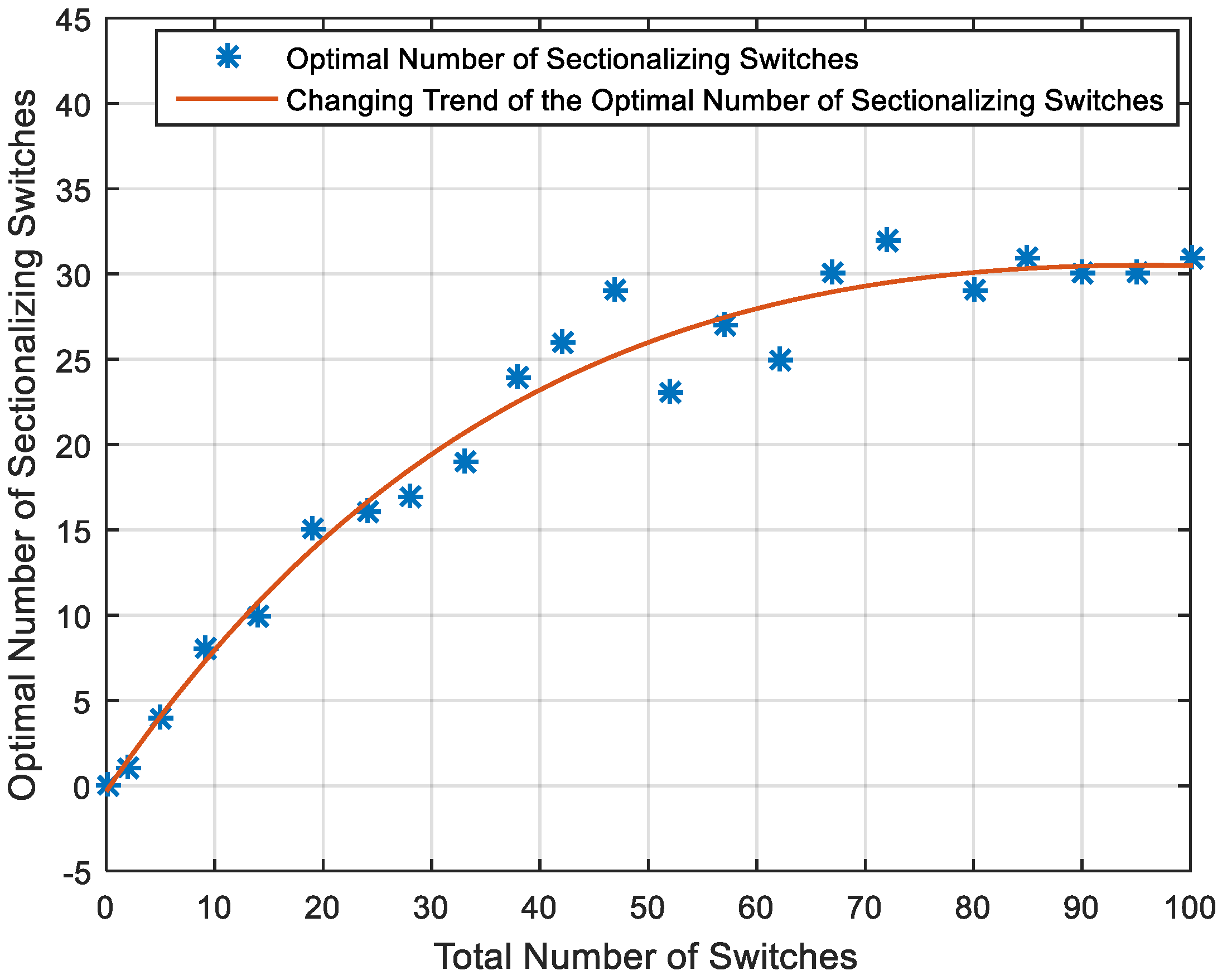


| Methods | Contributions | Comparisons |
|---|---|---|
| Topological flexibility quantification of active distribution networks (ADNs). | (1) This method quantifies the capability of ADNs to provide effective structural transformations based on the switch combination. (2) Community detection is applied to partition the distribution network. (3) An improved spectral clustering algorithm is employed to achieve the significant dimensionality reduction of partition space. | ——— |
| Power loss minimization using network reconfiguration [39]. | The reconfiguration and the optimal allocation of distributed generation (DG) units are simultaneously achieved by using the meta heuristic harmony search algorithm, which is effective in reducing power loss and improving the voltage profile. | The topological reconfiguration is based on the fixed switch placement in the distribution network, hence it provides limited connectivity modes of the distribution network. However, the topological flexibility quantification method in this paper can measure the topological modification capability of ADNs without limiting the switch placement. |
| Switch allocation for improving reliability [16]. | The approach minimizes the energy not supplied (ENS) by using sectionalizing and tie switches of different capacities with manual or automatic operation schemes. | The method uses switch combinations to minimize the ENS. Our approach gives a general description of the capability of switch combinations to bring structural changes to the distribution network. |
| Network reconfiguration using mixed-integer convex programming [40]. | The mixed-integer conic programming formulation is proposed to ensure the globally optimal solution of the distribution network reconfiguration problem. | The method uses the mixed-integer programming to solve the combination optimization problem. The method proposed in this paper can reduce the dimensionality of the combination optimization problem spatially after community detection. |
| Using reachability analysis approach to detect cyber-attack in a two-area power system [18]. | The reachability framework is proposed to identify the impact that an intrusion might have in the automatic generation control loop. | This method obtains the reachable set of the continuous state of the power system under cyber-attacks. The topological flexibility quantification method proposed in this paper is to study the reachable set of the discrete structure space of ADNs. |
| Reliability evaluation of distribution networks based on accessibility analysis [41]. | The method partitions the distribution networks and judges the failure consequence mode by using the accessibility matrix. | This method analyzes the connectivity of the power system by establishing an accessibility matrix, which is inherently different from the network structure reachable set that can be obtained through switch combinations in our method. |
© 2020 by the authors. Licensee MDPI, Basel, Switzerland. This article is an open access article distributed under the terms and conditions of the Creative Commons Attribution (CC BY) license (http://creativecommons.org/licenses/by/4.0/).
Share and Cite
Gu, H.; Chu, X. Quantifying Topological Flexibility of Active Distribution Networks Based on Community Detection. Energies 2020, 13, 4786. https://doi.org/10.3390/en13184786
Gu H, Chu X. Quantifying Topological Flexibility of Active Distribution Networks Based on Community Detection. Energies. 2020; 13(18):4786. https://doi.org/10.3390/en13184786
Chicago/Turabian StyleGu, Huizi, and Xiaodong Chu. 2020. "Quantifying Topological Flexibility of Active Distribution Networks Based on Community Detection" Energies 13, no. 18: 4786. https://doi.org/10.3390/en13184786
APA StyleGu, H., & Chu, X. (2020). Quantifying Topological Flexibility of Active Distribution Networks Based on Community Detection. Energies, 13(18), 4786. https://doi.org/10.3390/en13184786




